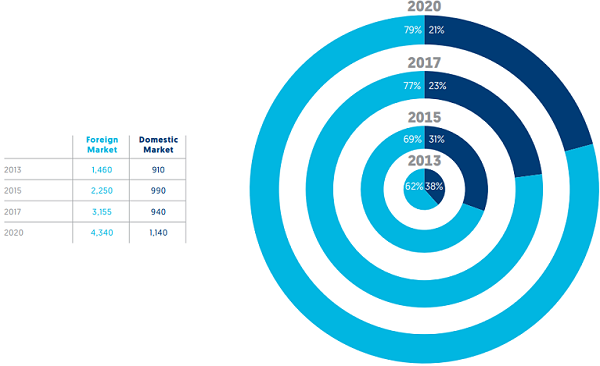Total turnover in the IT sector increased by 11 percentage points in 2017 compared to 2016 and exceeded the four billion euro threshold forecasted, according to Annual Report of the Employers’ Association of the Software and Services Industry (ANIS).
Domestic software and IT services market had a weaker development and only had a 2.1% growth in 2017 compared to the previous year, reaching EUR 975 million.
The association predicts that this trend will continue and it will be reached to the point where almost the entire growth will be supported by exports, which are expected to reach EUR 4 billion in 2019, by EUR 1 billion more than in 2017.
„We have an underdeveloped, frozen market, a situation that has a strong negative impact on the domestic ecosystem of hi-tech firms, which do not have a home market where they can test their products before approaching the foreign markets. It is hard to talk about investing in a country where virtually everything that is created is designed for exports,” said ANIS President Teodor Blidarus.
As an ANIS previous annual report (2016) mentioned, a unique phenomenon for this region happened in Romania: some IT companies have almost entirely captured the market for complex IT solutions provided to the public sector and state-owned companies (especially in energy and transport fields) and relations with political power play the most important role in awarding these contracts.
Last year’s report shows a decrease in the share of products acquired by the state.
The business sectors that contributed the most important shares to domestic revenue of the IT software and services market:
- manufacturing – 22%
- public sector – 20%
- banking – 16%
- telecom – 11%
- utilities, retail, services – 8%, each.
By comparison, in 2014, revenues of Romanian companies obtained in the country were:
- at the rate of 32% from projects carried out for the public administration
- 16% for customers in the manufacturing industry
- 14% for clients in the financial-banking sector
- 9% for telecom companies and 8% for companies in the utility sector.
How domestic demand evolved over the last few years
 Export – 75.6% of the total value
Export – 75.6% of the total value
Of the total volume obtained last year:
- the export of IT software and services contributes decisively, EUR 3,025 billion euro (75.6%, at the value of the entire IT sector, 14% up compared to the value registered in the previous year)
- internally generated revenue increased by only EUR 20 million (2.1%), from EUR 955 million recorded in 2016 to EUR 975 million in 2017. It is a trend of the last few years, primarily generated by a decline in the state’s demand for such products. For comparison, in 2015, this revenue increased by 10%.
- of the total exports of IT products and services, about 75% go to the European market, 22% to the US and the rest to other markets
Top 10 companies generate about a quarter of the market value
Out of top 300 largest IT software and services companies operating on the local market, 40% are Romanian companies.
Workforce in this sector
- total number of employees with full-time contracts in the software and IT services sector reached 89,850 specialists in 2017, which means an increase of 7,5% compared to 2016
- out of them, 88.6% hold technical positions and the others positions in non-technical departments
- three-quarters of companies with the largest number of employees have foreign capital.
Without incentives, growth capping is expected
For 2018, it is estimated that total revenues generated by the software and IT services industry to reach EUR 4.5 billion, but also a growth capping.
„It is pleasing that the tech industry continues to grow but the forecasts show that under similar conditions it will soon reach a plateau stage.
To maintain and accelerate the growth rhythm, companies need a predictable and healthy environment that encourages significant technology investments across the economy and the public system. At the same time, tech industry focuses its development priorities on the innovation area and education projects with medium and long-term impact, which is also reflected in ANIS projects,” said ANIS President Teodor Blidarus, quoted in the report.










